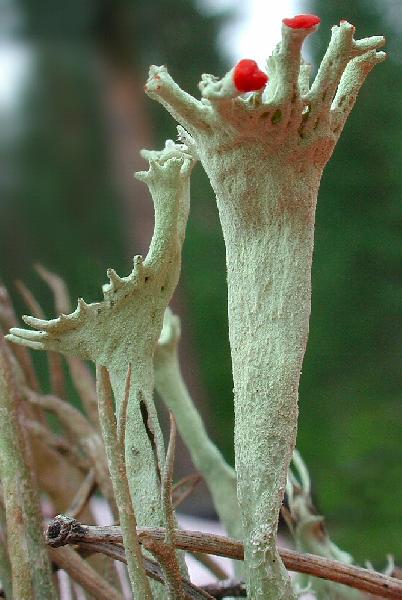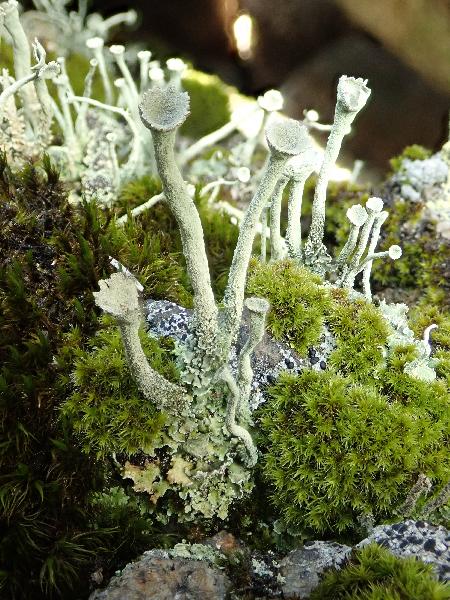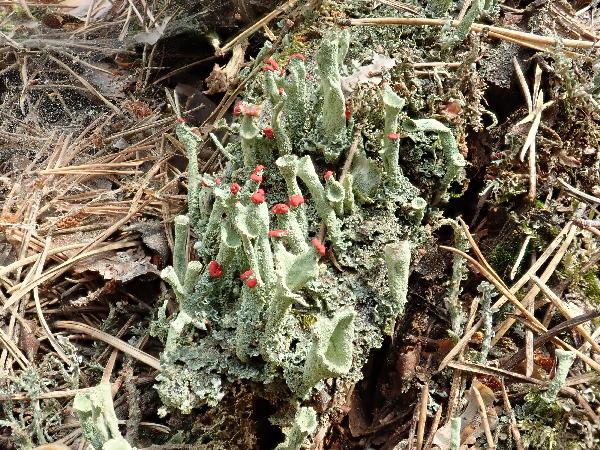Cladonia deformis (L.) Hoffm.
Deutschl. Fl., 2: 120, 1796. Basionym: Lichen deformis L. - Sp. Pl., 2: 1152, 1753.
Synonyms: Cladonia crenulata (Ach.) Flörke
Description: Primary thallus squamulose, often ephemeral, the squamules middle-sized, 0.5-3(-5) mm long, up to 2(-3) mm wide, rounded to crenate-lobate, yellowish green to yellowish grey on upper side, white beneath, but yellowish brown towards the attachment point, occasionally sorediate. Podetia yellowish green to greenish grey, orange yellow at the necrotic base, corticate only at base, 2-5(-9) cm tall and up to 5(-7) mm thick on the stalk, with narrow, more or less regular, gradually flaring and usually non-perforated cups, more rarely pointed, squamulose especially toward the base, farinose-sorediate in upper part and inside the cups, the soredia 30-60 μm in diam. Old herbarium specimens are covered in numerous crystals similar to fine needles. Apothecia rare, scarlet red, convex, developing at the margins of cups. Asci 8-spored, clavate, thickened at apex, with a K/I+ blue tholus and a K/I+ strongly blue outer gelatinous sheath, Cladonia-type. Ascospores 1-celled, hyaline, ellipsoid. Pycnidia scarlet red, semi-immersed along the margins of cups. Conidia hyaline, curved. Photobiont chlorococcoid. Spot tests: K-, C-, KC+ yellow, P-, UV-. Chemistry: usnic and isousnic acids, zeorin (deposited as needles on the surface of thallus), bellidiflorin, and traces of unknown terpenoids; rhodocladonic acid in apothecia and pycnidia.
Growth form: Fruticose
Photobiont: green algae other than Trentepohlia
Reproductive strategy: mainly asexual, by soredia, or soredia-like structures (e.g. blastidia)
Commonnes-rarity: (info)
Alpine belt: very rare
Subalpine belt: common
Montane belt: very rare
Dry submediterranean belt: absent
Humid submediterranean belt: absent
Padanian area: absent
pH of the substrata:
1 2 3 4 5
Solar irradiation:
1 2 3 4 5
Aridity:
1 2 3 4 5
Eutrophication:
1 2 3 4 5
Poleotolerance:
0 1 2 3
Altitudinal distribution:
1 2 3 4 5 6
Rarity
absent
extremely rare
very rare
rare
rather rare
rather common
common
very common
extremely common
Loading data...
Occurrence data
Predictive map
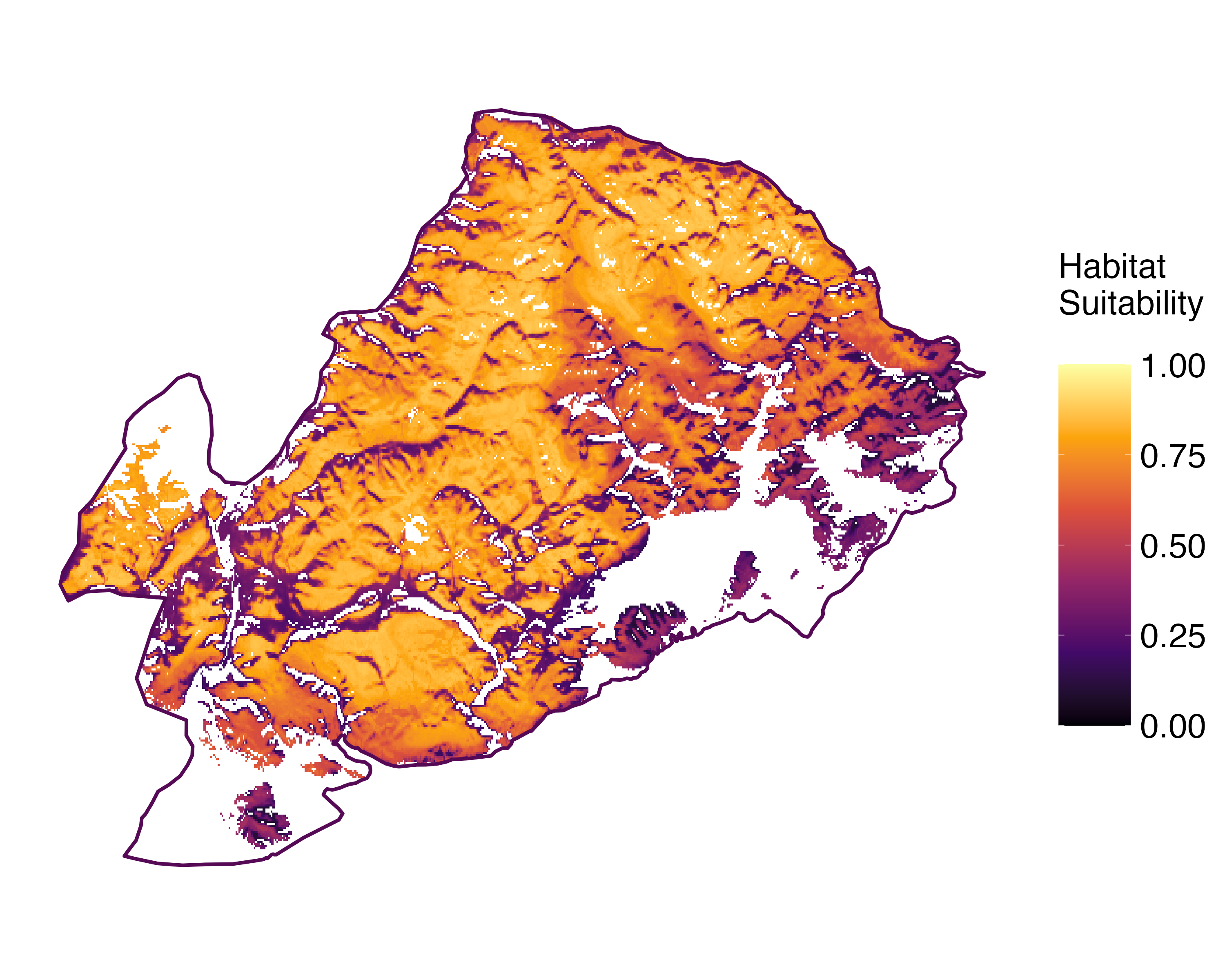 Current prediction (1981-2010)
Current prediction (1981-2010) Future prediction (2071-2100) SSP 1-2.6
Future prediction (2071-2100) SSP 1-2.6 Future prediction (2071-2100) SSP 5-8.5Predictive maps according to Francesconi et al. 2025
Future prediction (2071-2100) SSP 5-8.5Predictive maps according to Francesconi et al. 2025
P.L. Nimis; Owner: Department of Life Sciences, University of Trieste
Herbarium: TSB (2661)
2001/12/04
detail of cups

Felix Schumm – CC BY-SA 4.0
[16530], Österreich, nordöstlich von Ischgl beim Silvretta Stausee, ca. 2000 m. Leg. A. Matuschewski 07.2010. Det. Schumm 07.2010

Curtis Randall Björk – CC BY-SA 4.0
British Columbia, Boundary Ranges 2012-09-03 Understory of sub-boreal forest

Gabriele Gheza - https://lichenidilombardia.home.blog
Italy, Lombardia, Bergamo, Passo del Vivione, 1830 m
19/08/2016
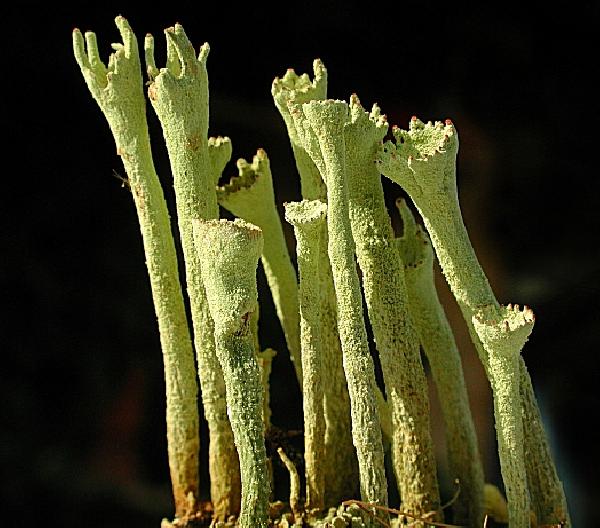
Ulrich Kirschbaum CC BY-SA 4.0 - Source: https://www.thm.de/lse/ulrich-kirschbaum/flechtenbilder
Sweden: Värmland.
Growth form: Fruticose
Photobiont: green algae other than Trentepohlia
Reproductive strategy: mainly asexual, by soredia, or soredia-like structures (e.g. blastidia)
Commonnes-rarity: (info)
Alpine belt: very rare
Subalpine belt: common
Montane belt: very rare
Dry submediterranean belt: absent
Humid submediterranean belt: absent
Padanian area: absent
pH of the substrata:
| 1 | 2 | 3 | 4 | 5 |
Solar irradiation:
| 1 | 2 | 3 | 4 | 5 |
Aridity:
| 1 | 2 | 3 | 4 | 5 |
Eutrophication:
| 1 | 2 | 3 | 4 | 5 |
Poleotolerance:
| 0 | 1 | 2 | 3 |
Altitudinal distribution:
| 1 | 2 | 3 | 4 | 5 | 6 |
Rarity
absent
extremely rare
very rare
rare
rather rare
rather common
common
very common
extremely common
Loading data...
Occurrence data
Predictive map
 Current prediction (1981-2010)
Current prediction (1981-2010) Future prediction (2071-2100) SSP 1-2.6
Future prediction (2071-2100) SSP 1-2.6 Future prediction (2071-2100) SSP 5-8.5
Future prediction (2071-2100) SSP 5-8.5Predictive maps according to Francesconi et al. 2025

P.L. Nimis; Owner: Department of Life Sciences, University of Trieste
Herbarium: TSB (2661)
2001/12/04
detail of cups

Felix Schumm – CC BY-SA 4.0
[16530], Österreich, nordöstlich von Ischgl beim Silvretta Stausee, ca. 2000 m. Leg. A. Matuschewski 07.2010. Det. Schumm 07.2010

Curtis Randall Björk – CC BY-SA 4.0
British Columbia, Boundary Ranges 2012-09-03 Understory of sub-boreal forest

Gabriele Gheza - https://lichenidilombardia.home.blog
Italy, Lombardia, Bergamo, Passo del Vivione, 1830 m
19/08/2016











